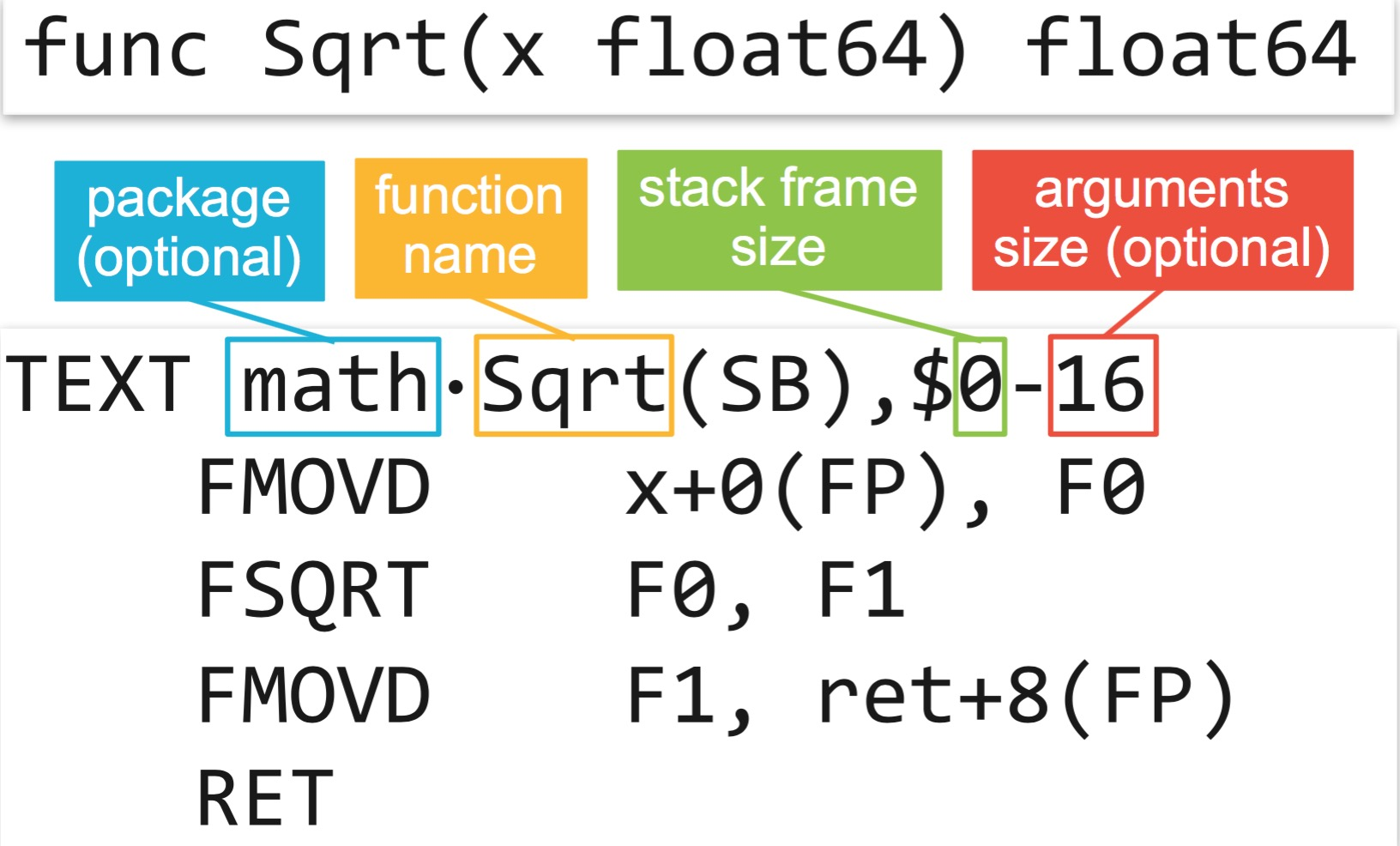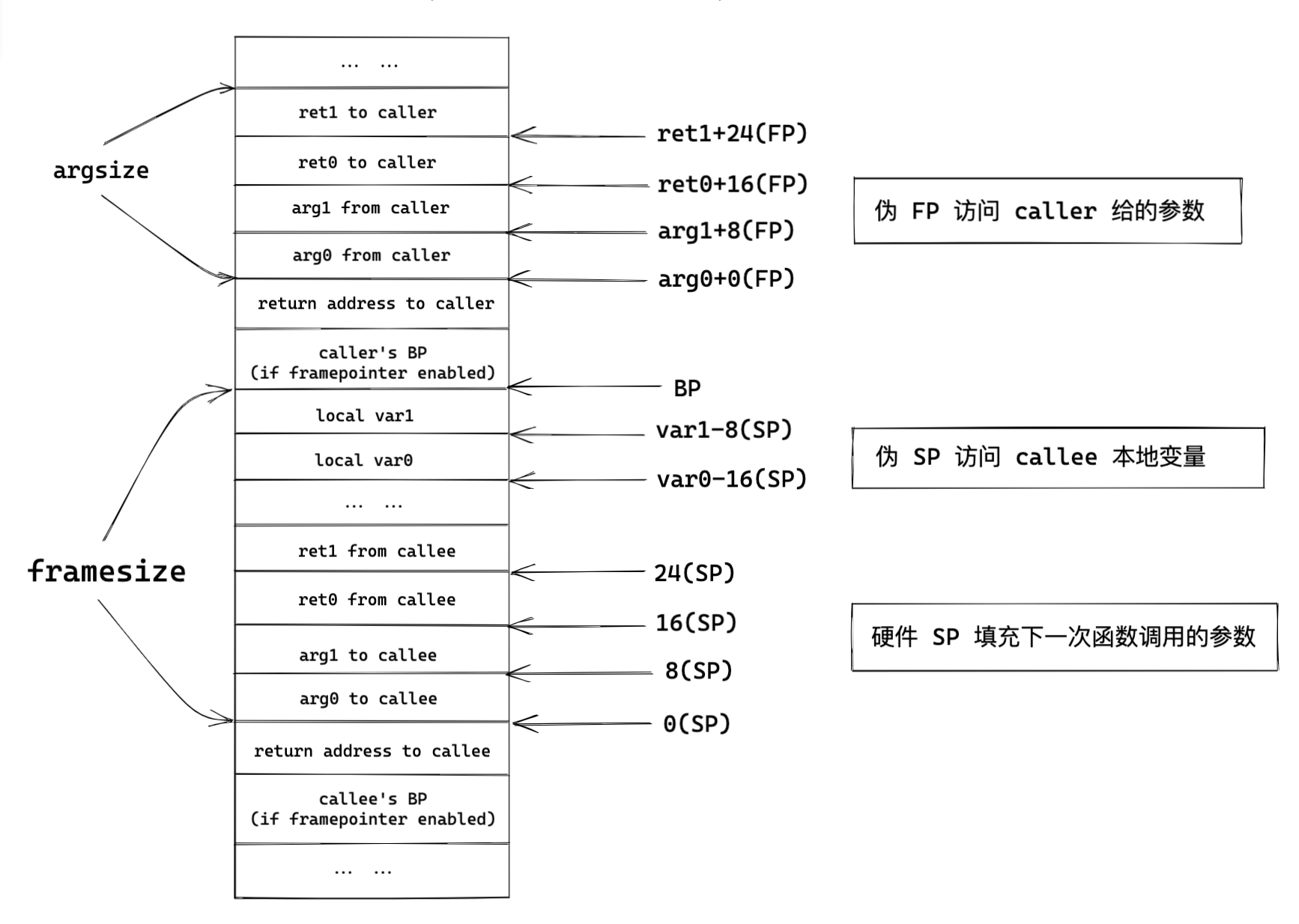Direction
The plan9 assembly operand direction is the opposite of the intel assembly direction, plan9 is left to right and intel is right to left.
Stack push and pop
In plan9, there is no PUSH POP instruction for stack operation, but SUB and ADD respectively.
SP is the top of stack pointer, which corresponds to BP bottom of stack pointer, usually only need to operate SP pointer to complete push and pop operations, so BP pointer is not used much.
Data Copy
The commands starting with MOV are used to move data, and the amount of data that can be moved at one time varies with the variety of commands provided.
Operation commands
- ADD to add
- SUB to subtract
- IMUL for multiplication
Jump Instructions
The jump instruction is the key to switch the flow of program execution.
|
|
Constant definition
plan9 assembly uses num to represent constants, which can be negative, the default is decimal and can be used in the form of 0x123 for hexadecimal
Variable declarations
Variables in assembly are generally read-only values stored in .rodata or .data segments. This corresponds to global const and var variables/constants that have been initialized at the application level.
-
DATA can declare and initialize a variable
1DATA symbol+offset(SB)/width,valueThe above statement initializes the symbol+offset(SB) data in width bytes, assigning it to value.(SB operations are all incremental)
-
GLOBL declares a global variable
If under Go package, GLOBL can export the DATA initialized variables for external use
Go’s registers
Go assembly introduces 4 pseudo-registers PC, FP, SP, SB to simplify the writing of assembly code, plus other general registers which are the Go assembly language’s re-abstraction of the CPU.
Take AMD64 environment as an example, the purpose of each register is explained
Pseudo PC registers
- Meaning: Alias of IP register, pointing to instruction address
- Purpose: Used to indicate the address of the next instruction (logical address, i.e., offset), normally, the system instructs to add 1 to it, when encountering transfer instructions, such as JMP, CALL, LOOP, etc., the system will save the jump to the instruction address in the PC
- Frequency of use: Except for individual jumps, handwritten code deals with PC registers less often
Pseudo SB register
- Meaning: can be interpreted as raw memory, pointing to the global symbol table
- Usage: Generally used to declare functions or global variables
- Usage: foo(SB) means use foo to represent an address in memory. foo(SB) can be used to define global functions and data. foo<>(SB) means foo is only visible in the current file, similar to the effect of static in C. In addition, you can add an offset to the reference, for example, foo+4(SB) means the address of foo+4bytes
- Frequency of use: commonly used
BP register
- Meaning: indicates the
start stack baseof the function call stack (the direction of the stack is from large to small, the true SP indicates the top of the stack), and records theend positionof the current function stack frame - Usage: Store the stack base address before entering the function, and use with true SP to maintain the function call stack relationship
- Use.
- Function call-related instructions implicitly affect the value of BP
- The BP register on the X86 platform is usually used to indicate the starting position of the function stack, and is only used as an indicator.
- But some debug tools may use this register to find function parameters, local variables, etc.
- So on amd64 platform, compiler will insert 8 byte after return address to place caller BP register
- If you need to maintain the call stack manually, you need to use the BP register and split the call stack manually.
SP register
- Meaning.
True SP registerindicates theend stack topof the function call stack (the direction of the stack is from largest to smallest, BP indicates the bottom of the stack), and records theend positionof the current function stack frame.Pseudo-SP registerindicates thehighest start addressof the local variable.
- Uses.
- True SP is generally used for stack allocation, stack release, etc.
- Pseudo-SP is generally used to locate local variables.
- Pseudo-SP use.
- Pseudo SP starts at the high address of the local variable, so you need to use
negative offsetwhen using it. - Used by symbol+offset(SP), the legal value of offset is [-framesize, 0)
- For example, b-8(SP) means that the local variable b is at the 8th byte of the pseudo-SP
- Pseudo SP starts at the high address of the local variable, so you need to use
- Use of true SP.
- True SP starts at the low address of the function stack frame, and the compiler adds or subtracts the SP pointer to achieve stack allocation and stack release
- Stack allocation and release are allocated in a single addition and subtraction operation
- Frequency of use: both true and false SP are commonly used (the compiler eventually generates true SP)
Pseudo FP registers
- Meaning:
compilermaintains on-stack parameter pointers based on FP offsets, identifying parameters - Use: Generally used to identify and access the arguments and return values of a function
- Usage: To access the arguments of a specific function, the compiler forces that the FP must be accessed using the
identifier prefix, e.g. foo+0(FP) for the first argument of foo, foo+8(FP) for the second argument, and 64-bit systems with offsets to access more arguments - Relationship to pseudo-SP registers:
- Pseudo FP is the base address for accessing incoming and outgoing parameters, usually addressed by
positive offsets. - Pseudo SP is the base address for accessing local variables, usually addressed by `negative offset
- Pseudo FP is the base address for accessing incoming and outgoing parameters, usually addressed by
- Frequency of use: commonly used
General Purpose Registers
- AX, BX, CX, DX, DI, SI, R8-R15
MMX registers
- R0-R7 are not general-purpose registers, they are only exclusive to the MMX instruction introduced from X87 onwards
TLS pseudo-registers
- This register stores the address of the current goroutine g structure
Frequently Asked Questions
1. How can I view the Go assembly code?
For those who want to learn Go assembly language, we can look through the Go source code, which has a lot of assembly examples in practice. In addition, we can also analyze the compiled code of our Go programs through disassembly and other means to understand some underlying mechanisms and principles.
Here are some commands to get the compiled code.
-
Compile output
-
Disassembly
-
SSA analysis
The SSA analysis generates an ssa.html page, which can be opened to see the whole process of compiling a Go program, the last step being the assembly instructions we want.
1GOSSAFUNC="main" go build main.go
2. What do framesize and argsize mean when they are specified in an assembly function?
- framesize means the entire stack frame size of the function
- including local variables as callee
- including the return value argument as caller
- including input arguments as caller
- does not include parent caller BP
- does not include the return address function return address
- argsize indicates the size of the space allocated for the function input and return values as a caller
- When there is a NOSPLIT marker, the size of the input arguments and return value can be omitted
- can be omitted because the compiler can derive the size of function arguments from the Go language function declaration
- If framesize is greater than 0 and framepointer enabled, the BP register is also stacked, and the true SP register is offset down by framesize bytes to allocate stack space

3. How to distinguish between true and false registers?
- Pseudo registers generally need an identifier and offset as prefix, if there is no
identifier prefix, they are true registers - (SP), +8(SP) are true SP registers without an identifier prefix, while a(SP), b-8(SP) are pseudo SP registers with an identifier prefix
4. The relationship between FP and SP registers in AMD64 environment?
-
Scenario
- We assume the scenario is when caller calls callee, framesize is greater than 0, and BP registers are stacked
- We restrict NOSPLIT to not allow leaf function stack splitting
- caller’s FP pointer is at the high address above, and callee’s true and false SPs are at the low address, spanning both caller and callee functions
-
Relationship
- pseudo FP = true SP + framesize + 16
- arg0+0(FP) = 0(SP) + framesize + 16
- Note: The 16 bytes here store the 8-byte parent caller BP, and the 8-byte return address, respectively
- Pseudo-SP = true SP + framesize
- Description: The pseudo-SP is pointing to a location below the low address of the BP
- pseudo FP = pseudo SP + 16
- pseudo FP = true SP + framesize + 16
-
Caution
- Pseudo SP and pseudo FP registers are calculated based on the true SP, which is convenient for quick operation.
- When the true SP register is modified, the pseudo SP and pseudo FP registers will be moved in the same way.
- Therefore, it is better not to modify the true SP and leave it to the compiler.

5. What happens to the stack frame during the function call?
- Execution of the CALL instruction, the caller
- return address after a stacked function call return address (addr of the subsequent instruction of the caller executed after callee returns to the caller)
- Jump to the address of the instruction pointed to by the PC register
- Allocate the callee stack frame
- At the head of the function call, the compiler inserts 3 instructions
- The first one:
SUBQ $16, SPallocates the stack frame of callee, moving sp down 16 bytes, which is the top of the stack ofcallee. - Second:
MOVQ BP, 8(SP)Back up the caller’s BP stack base below the return address (at the low address) - Third:
LEAQ 8(SP), BPpoints the BP register to callee’s stack base (for 0x48(SP), this location iscallee's stack base)
- The first one:
- At the head of the function call, the compiler inserts 3 instructions
- Execute the instructions that follow the TEXT segment of the callee function.
- Restore the caller’s stack frame
- Before the function returns, you need to restore the caller’s stack frame, the compiler will insert 2 instructions to the end of the `function
- The first one:
MOVQ 8(SP), BPrestores the BP stack base address of the caller - The second instruction:
ADDQ $16, SPfrees up the stack space of callee, and the SP register is naturally restored to the original position of caller
- The first one:
- Before the function returns, you need to restore the caller’s stack frame, the compiler will insert 2 instructions to the end of the `function
- Execute the RET instruction and return
- Return address out of the stack return address
- PC register jumps to return address
- Execute the instruction at return address, and caller resumes execution
Summary
In Go’s assembly, there are many unique pseudo-registers to help users quickly locate the corresponding hardware registers, global variables, functions, concurrent procedures, etc., which is really convenient. On the other hand, if you don’t understand the mechanism and stack layout of these pseudo-registers in Go, you will have a hard time.
For writing and learning Go assembly, many register operations are transparent, and we should focus on the layout of return parameters, input parameters, and local variables on the stack frame in function calls. The compiled assembly instructions will also be converted to true SP registers, and there are no pseudo registers.
The others, pseudo PC, pseudo SB registers, pseudo TLS registers, etc., can be understood as long as they exist. bp registers, although they have a low presence, are still useful for understanding the layout of function stacks.